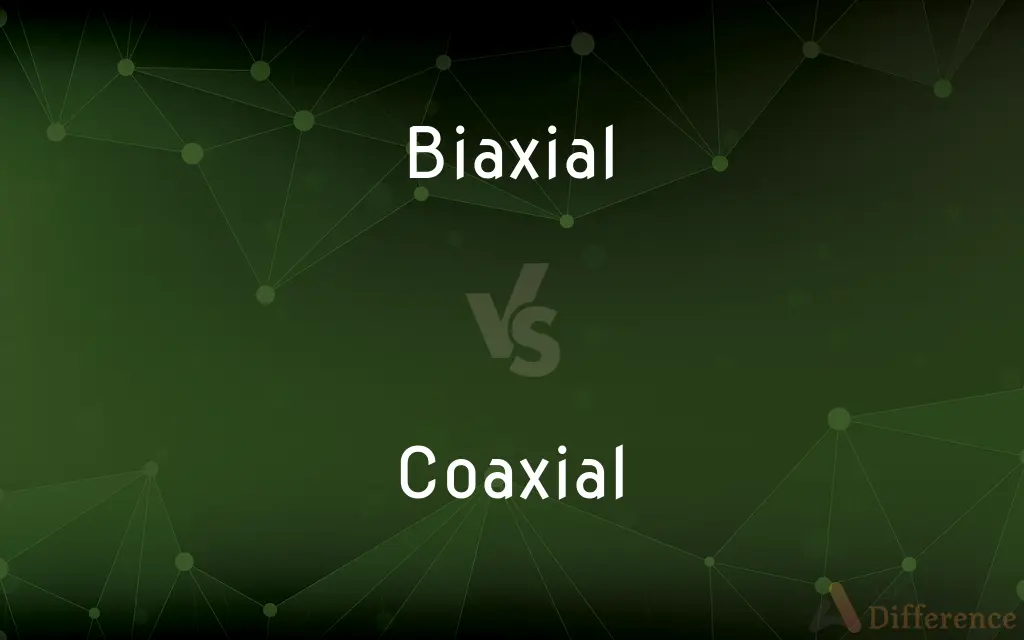Biaxial vs. Coaxial — What's the Difference?
Edited by Tayyaba Rehman — By Urooj Arif — Updated on April 15, 2024
Biaxial refers to having two axes of rotation or symmetry, while coaxial involves components sharing a common axis, typically in cylindrical forms.

Difference Between Biaxial and Coaxial
Table of Contents
ADVERTISEMENT
Key Differences
Biaxial systems, like certain crystals or mechanical setups, have two distinct axes around which they exhibit rotational or symmetrical properties. On the other hand, coaxial configurations involve elements like cables or rotating parts that align along a single shared axis, optimizing space and reducing interference.
In the realm of material science, biaxial orientation involves stretching a material along two perpendicular axes to improve strength and clarity. Coaxial designs, however, are often seen in electrical engineering, where cables are structured with concentric layers of conductors and insulators to prevent electromagnetic interference.
Biaxial movements in machinery allow for complex motion, as seen in some robotics and manufacturing tools, facilitating versatility in multiple planes. Whereas, coaxial rotors in helicopters provide stability and control by counteracting the torque effects with two sets of rotors spinning in opposite directions.
The concept of biaxial testing involves applying stress along two axes simultaneously to evaluate the mechanical properties of materials. Conversely, coaxial connectivity, such as in audio or video setups, ensures that signals are transmitted directly along a straight, uninterrupted path, enhancing signal clarity and strength.
Biaxial mapping in geology can help in understanding strain patterns and rock deformations across two main directions. Coaxial setups, in contrast, are crucial in the construction of coaxial speakers, where drivers are aligned along a single axis to improve sound directionality and phase alignment.
ADVERTISEMENT
Comparison Chart
Definition
Having two axes of rotation or symmetry
Having components sharing a common axis
Common Uses
Material science, robotics, geological mapping
Electrical cables, helicopter designs, audio equipment
Benefits
Enhanced strength and flexibility in multiple directions
Reduced interference, improved signal integrity
Typical Configurations
Crystals, films, and machinery with two perpendicular axes
Cables with concentric layers, coaxial rotors, coaxial speakers
Key Characteristics
Facilitates movements or stress tests in two axes
Aligns elements linearly for compactness and efficiency
Compare with Definitions
Biaxial
Pertaining to or involving two axes.
The biaxial crystal structure allows for unique optical properties.
Coaxial
Components or assemblies sharing a common axis.
Coaxial cables are commonly used to connect satellite dishes to TVs.
Biaxial
The process of stretching material in two perpendicular directions.
Biaxial stretch improves the barrier properties of plastic films.
Coaxial
A type of cable with an inner conductor surrounded by a concentric conducting shield.
The technician checked the coaxial cable for any signs of wear or damage.
Biaxial
A load applied along two axes simultaneously.
The bridge was designed to withstand biaxial loads due to varying traffic patterns.
Coaxial
A helicopter rotor configuration with two rotors mounted one above the other on the same axis.
The coaxial rotor design helps reduce the helicopter's noise output.
Biaxial
A joint capable of moving in two planes.
The robot's biaxial joint allows it to maneuver complex parts accurately.
Coaxial
A loudspeaker system where the drivers are mounted on the same axis.
His new coaxial speakers provide a clearer and more direct sound.
Biaxial
Testing a material by applying forces in two different axes.
Biaxial testing was used to determine the fabric's durability under stress.
Coaxial
The alignment of two or more components along a single axis.
Precise coaxial alignment is crucial for the machine's accurate performance.
Biaxial
Having two axes.
Coaxial
In geometry, coaxial means that several three-dimensional linear or planar forms share a common axis. The two-dimensional analog is concentric.
Biaxial
Having two axes.
Coaxial
Having or mounted on a common axis.
Biaxial
Having two axes of rotation and two planes of symmetry (e.g. having the shape of a spheroid)
Coaxial
(geometry) Having a common central axis
Biaxial
Having a value in two perpendicular directions. (In solid mechanics, it generally means that normal stresses exist in two of the possible three directions, though not necessarily equal in sign or magnitude.)
Coaxial
A coaxial cable
Biaxial
Having two axes;
Biaxial crystals
Coaxial
Having a common axis.
Coaxial
Having a common axis
Common Curiosities
Can both biaxial and coaxial systems be found in electronics?
Yes, biaxial systems can be seen in device mechanisms like gyroscopes, while coaxial systems are common in cables and connectors.
What is biaxial alignment?
Biaxial alignment refers to the orientation along two axes, enhancing structural or mechanical performance.
Can biaxial designs be used in all types of materials?
They are most beneficial in composites and textiles where directional strength and flexibility are important.
Is there a significant cost difference between biaxial and coaxial designs?
The cost can vary significantly based on application specifics, with coaxial designs typically more expensive due to their precision components.
What distinguishes a biaxial system from a coaxial system?
A biaxial system operates or is structured around two axes, whereas a coaxial system components share a common single axis.
How do biaxial and coaxial systems affect mechanical design?
Biaxial systems allow for movement and strength across two axes, beneficial in dynamic mechanical designs, while coaxial systems are preferred for their compact and efficient linear arrangements.
How do coaxial cables minimize interference?
They use an inner conductor, insulating layer, and outer shielding to protect signals from electromagnetic interference.
What are the advantages of using coaxial cables over other types?
Coaxial cables prevent electromagnetic interference, ensuring higher signal quality and security.
Why might a biaxial test be preferred in material testing?
Biaxial testing can more accurately simulate real-world multi-directional stress conditions on materials, providing a better assessment of durability and performance.
What applications benefit from biaxial testing?
Industries requiring detailed understanding of material behavior under multidirectional stresses, such as aerospace and automotive.
Why are coaxial components preferred in electronic systems?
They ensure consistent signal transmission and minimize interference, essential for high-quality audio, video, and data transfer.
How do biaxial movements enhance robotics?
They allow robots to operate more flexibly and handle complex tasks by moving in multiple directions simultaneously.
Share Your Discovery

Previous Comparison
Workflow vs. Pipeline
Next Comparison
Equal vs. EquableAuthor Spotlight
Written by
Urooj ArifUrooj is a skilled content writer at Ask Difference, known for her exceptional ability to simplify complex topics into engaging and informative content. With a passion for research and a flair for clear, concise writing, she consistently delivers articles that resonate with our diverse audience.
Edited by
Tayyaba RehmanTayyaba Rehman is a distinguished writer, currently serving as a primary contributor to askdifference.com. As a researcher in semantics and etymology, Tayyaba's passion for the complexity of languages and their distinctions has found a perfect home on the platform. Tayyaba delves into the intricacies of language, distinguishing between commonly confused words and phrases, thereby providing clarity for readers worldwide.














































